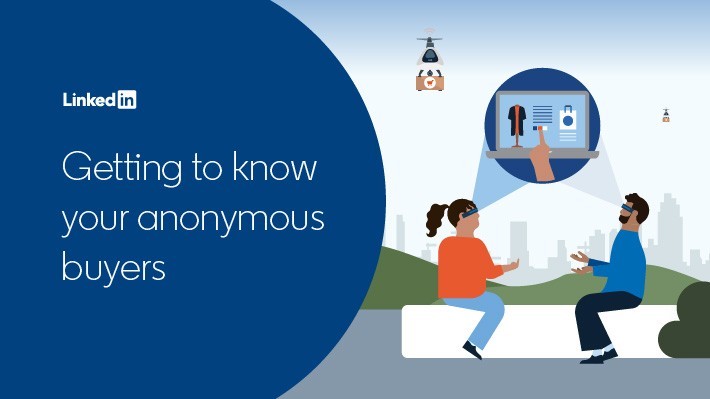Five marketing strategies for engaging with anonymous buyers
We live in an age of personalised, anonymous marketing. On the one hand, consumers expect to receive highly tailored, timely messaging and recommendations - the kind of thing we all get when we log on to Amazon, Netflix, or Spotify. But, on the other, if a salesperson from any of our favourite brands actually picked up the phone – or worse still, physically knocked on the door - most of us would be horrified. We want personal - but not that kind of personal.
And it’s exactly the same with B2B technology buyers, as revealed by the latest LinkedIn Technology Buyers Report, The Age of Agility 20/21, a survey of 2,000+ tech buyers across EMEA. It found that nearly three quarters (70%) will do their own research before contacting a vendor, while only a quarter are happy to leave details to access content. And to make matters even tougher for marketers, there are more individuals involved in tech buying than ever before, spanning marketing, sales, finance, and beyond, with over half dropping off after the researching and shortlisting stages.
Marketers therefore face the challenge of making a connection with buyers and providing a personalised buying journey, without asking for any personal details in the process. Sound tricky? It doesn’t have to be. Here are five strategies for delivering a highly personal buying process, without overstepping the mark:
Show what you stand for
Making a personal connection with your buyers doesn’t just involve focusing on them. A big part of building that personal relationship is first defining clearly what your brand stands for, by developing and nurturing a purpose and brand values that will resonate across all your audiences and thread through all your campaigns. This kind of brand building will help to draw anonymous buyers into the top of the funnel, by showing that you are the kind of company that they would like to do business with. Then from there, you can look to tailor your content and messaging to each buyer’s particular needs.
“…companies in the B2B space are increasingly asking for aligned purpose when it comes to the businesses they choose to work with,” explains Ruth Rowan, Chief Marketing Officer at NTT Ltd. “Tender processes increasingly involve questions around shared vision and goals, and commitments in areas like carbon neutrality. Purpose is increasingly essential for your right to bid.”
Agile, data-driven content
Just because your buyers don’t want to hand over their personal details doesn’t mean you can’t find out their needs and preferences and tailor content and messages accordingly. Maximise the data you do have at your disposal, from market research, to keyword analysis, and real-time website engagement and analytics, to build a picture of your audience groups, and what they care about. The business landscape and customer needs are changing all the time, so content needs to be responsive. A data-driven strategy ensures campaigns are role-specific, problem-specific and moment-specific, with something to meet the needs of each individual buyer.
“We try to become more buyer-oriented further down the funnel,” says Alysha Spencer, Head of Enterprise Acquisition and Upsell Marketing at O2 “As consumers, people increasingly expect bespoke, personalised experiences, and we want to be able to provide those for our customers. We’re using data to understand the challenges for different functions so that we can really pull out the benefits for HR, IT or Operations and articulate them in our creative and messaging.”
Self-personalised buyer journeys
An increasingly popular way of creating hyper-personalised buyer journeys, without sacrificing anonymity, is to empower your website visitors to personalize their own experience as they go. This could involve integrating a chatbot, an online questionnaire, or decision-tree into your customer journey, to ask buyers about their role, interests and challenges. From there, customers are offered advice on next steps, suitable products and services, or directed to information that they may find valuable. Buyers receive the same kind of personalization that they would with a human salesperson but without losing any control.
Employee, and user-generated content
Another way of providing the real-world salesperson touch, but without the intrusion, is to use your salespeople in online content. For example, can you feature employees in ‘how to’ videos, podcasts, or online webinars? This is something that T-Systems International is doing, to provide greater authenticity, as Björn Radde, The Head of Digital Marketing, explains: “Personally, I’d always be more interested in listening to real people talk about tech solutions than just hearing from a business – we need to be authentic, and content from employees is one of the best ways of doing that.”
The personal touch is equally, if not more effective, when it involves your customers, who can provide social proof and third-party recognition of your products and services. The Age of Agility Report 20/21 found that professional peer reviews are the most important factor for building trust with your audiences. Providing authenticity, relevance and emotional impact, your existing customers have an ability to connect with anonymous buyers better than anyone else.
Give away value early
All of these strategies will help to push your anonymous buyers further down the buying funnel, encouraging them to consider your products and services. You’ve been sensitive to their desire for anonymity, however once you’ve gained their trust, a good way to tentatively initiate that first contact is through offering them access to something more exclusive. That could be a trial of your product or service, a freemium subscription, or an invitation to an event or conference. Doing this gives them a strong incentive to get in touch and provide their contact details, so you have an excuse to continue the conversation in person (or at least over Zoom).
T-Systems International has done this effectively by offering customers the opportunity to attend a virtual version of its innovation centre in Munich: “The people who sign up don’t just become leads – they also have an appointment to engage with sales in a distinctive, memorable way,” explains Björn.
The days of the traditional tech buyer, and the traditional tech buying journey, are over. A range of different audiences are now dipping in and out of the customer journey, often in a non-linear fashion, each with their own perspective and particular needs. They don’t want to see generic content, but nor will they hand over their email or phone number. It is up to marketers to think creatively, to develop a shared vision and understanding with these anonymous buyers. Gaining their trust is about listening, responding and adding as much value as possible. Then patiently waiting for them to make the first move.
The LinkedIn B2B Technology Buying Survey – Age of Agility EMEA Report 20/ 21 lays out the five key trends in a new and dynamic landscape for technology marketers. Discover what your buyers need from you today.
Topics: Targeting and audience building Tech marketing LinkedIn Ads
Related articles



